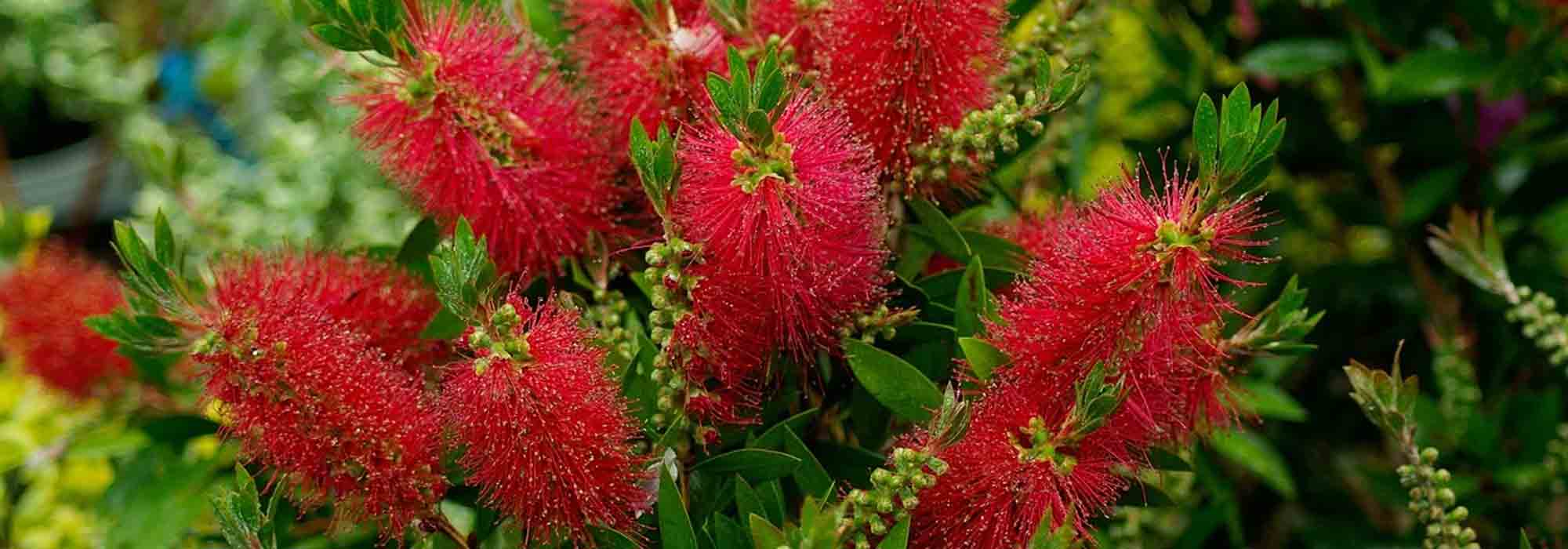
Callistemon or bottlebrush: best varieties
Discover 8 floriferous and colourful varieties.
Contents
The Callistemon or Bottlebrush is a magnificent floriferous bush with evergreen foliage. During the main season (between May and September), it produces superb bottlebrush flowering, hence the nickname ‘bottlebrush tree’. Callistemons prefer neutral to acidic, above all well-drained, soils, and sunny to semi-shaded positions. There are a large number of species and varieties of bottlebrush. Here therefore is a selection of the 8 best Callistemon varieties to help gardeners choose.
Callistemon laevis : a charming, very floriferous bush
Callistemon x laevis is also one of the most cultivated varieties in Mediterranean gardens. This lovely bush, probably of horticultural origin, reaches 1.80 m and has a spreading habit. Evergreen foliage of this Callistemon consists of leathery, bright green leaves that take on a pretty salmon-red hue at bud burst period. This red bottlebrush plant can flower repeatedly throughout the warm season, between May and September. Its abundant flowering takes the form of superb bright red bottlebrushes which, as they fade, adopt a surprising magenta-pink shade. It is a not very hardy variety that does not tolerate temperatures below -7°C. Callistemon x laevis is however very drought-tolerant, and flowers more abundantly in fresh, slightly calcareous soil. 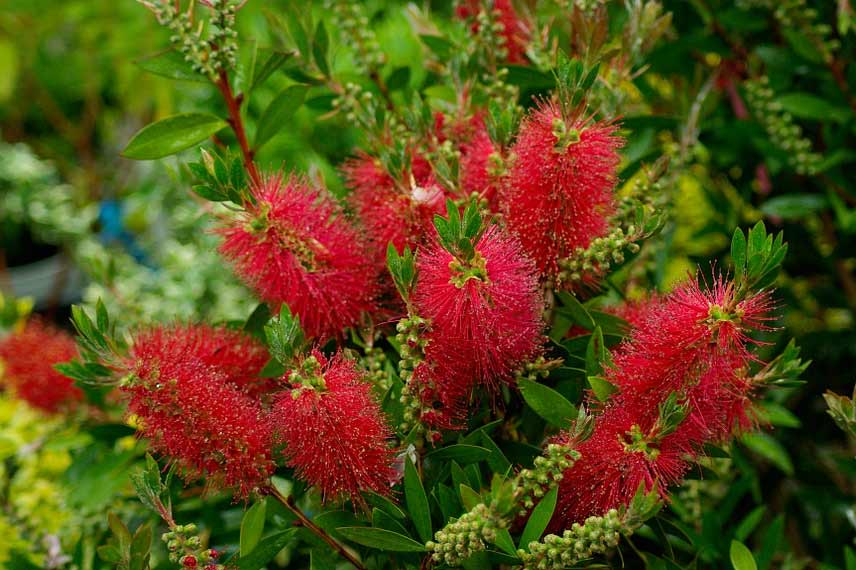
Some planting combinations
Callistemon x laevis₁ can for example be paired with Kolkwitzia amabilis ‘Pink Cloud’₂, with Cistus creticus (Cretan rockrose)₃, with Cotinus coggygria ‘Royal Purple’₄, and with Corokia cotoneaster₅ to create a beautiful flowering hedge. 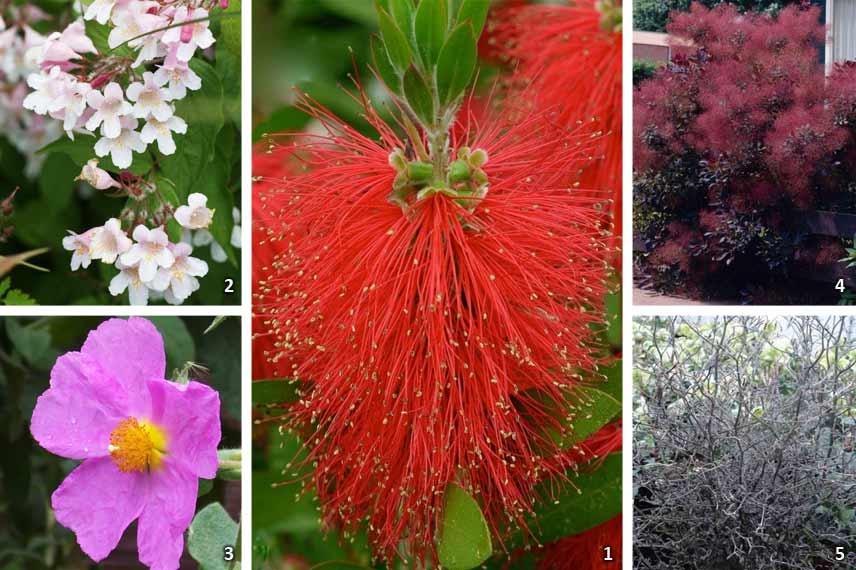
Callistemon citrinus Splendens: a handsome, slightly weeping bush
Callistemon citrinus ‘Splendens’ is one of the varieties most planted in our gardens. It forms a compact bush 2.5 m high, with a slightly weeping habit. This bottlebrush tree is provided with splendid aromatic foliage that releases scent when crushed, showing a bright light green colour tinged with orange‑red. Its beautiful flowering occurs between June and August and takes the form of magnificent, very bright red bottlebrushes. It is a relatively hardy variety that withstands temperatures down to around −7 °C to −8 °C and tolerates drought once well established. Callistemon citrinus ‘Splendens’ particularly enjoys neutral or acidic soils that are not too dry.
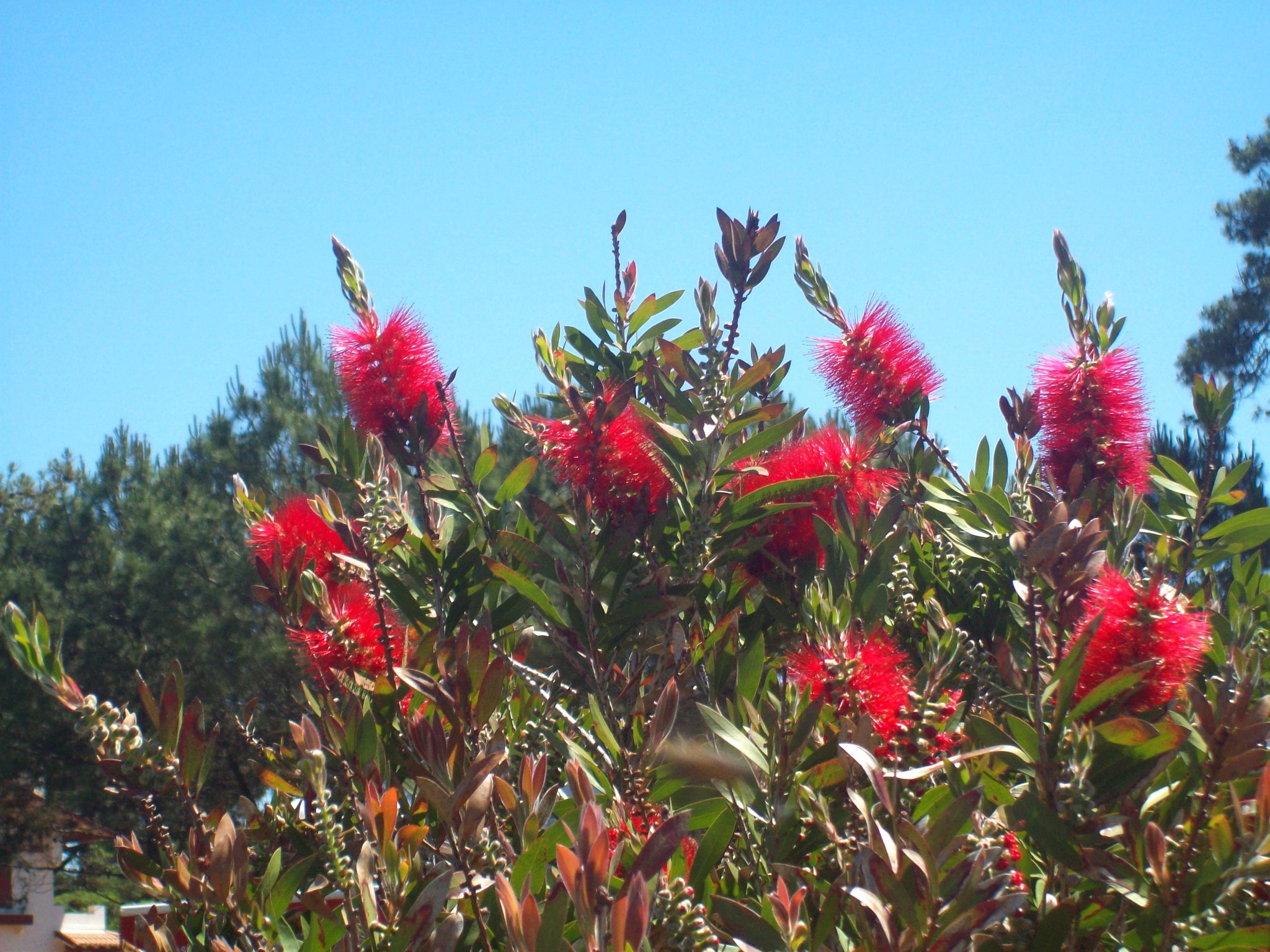
Callistemon citrinus ‘Splendens’ – ©Miluz, Flickr
Some planting combinations
Callistemon citrinus ‘Splendens’₁ can, for example, be paired with Phormium ‘Jester’₂, with Senecio greyi ‘Sunshine’₃, with clumps of French lavender₄ and Helichrysum italicum₅ as well as with Euphorbia characias₆. 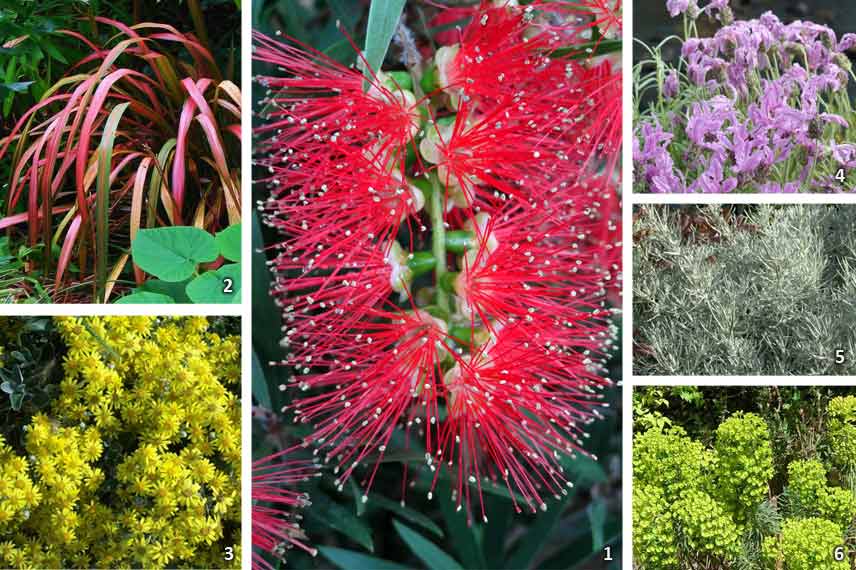
Discover other Callistemon
View all →Available in 2 sizes
Available in 1 sizes
Available in 2 sizes
Available in 1 sizes
Available in 1 sizes
Available in 2 sizes
Available in 2 sizes
Available in 2 sizes
Available in 1 sizes
Available in 2 sizes
Callistemon viminalis: the most widely planted bottlebrush in the world
Callistemon viminalis is a bush widely grown in gardens benefiting from a mild winter climate. This magnificent bottlebrush reaching 7 m high has a dense crown made up of arching branches that have earned it the name weeping Callistemon. Its evergreen leaves display an attractive green, slightly grey colour, very elegant. Its spectacular bottlebrush flowers are a striking red. They appear in spring as inflorescences in spikes, and persist throughout the growing season from May to June, then from August to September. A species not very hardy, Callistemon viminalis does not tolerate temperatures below -5°C. It is an adaptable bush that tolerates coastal exposure well, but prefers soils that are not very calcareous. 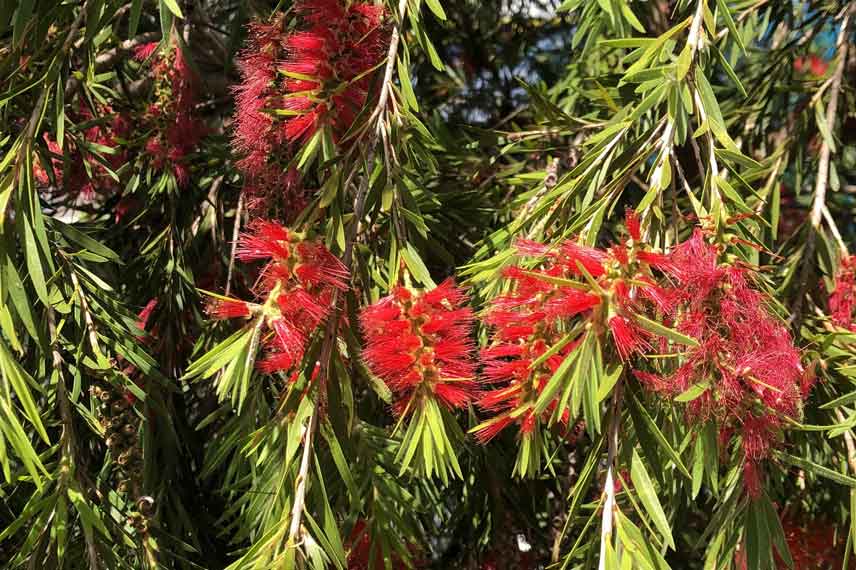
Some planting combinations
Callistemon viminalis₁ can, for example, be paired with Myrtus communis₂, with Nerium oleander₃, and with Ceanothus ‘Skylark’₄ to create very attractive evergreen hedges. 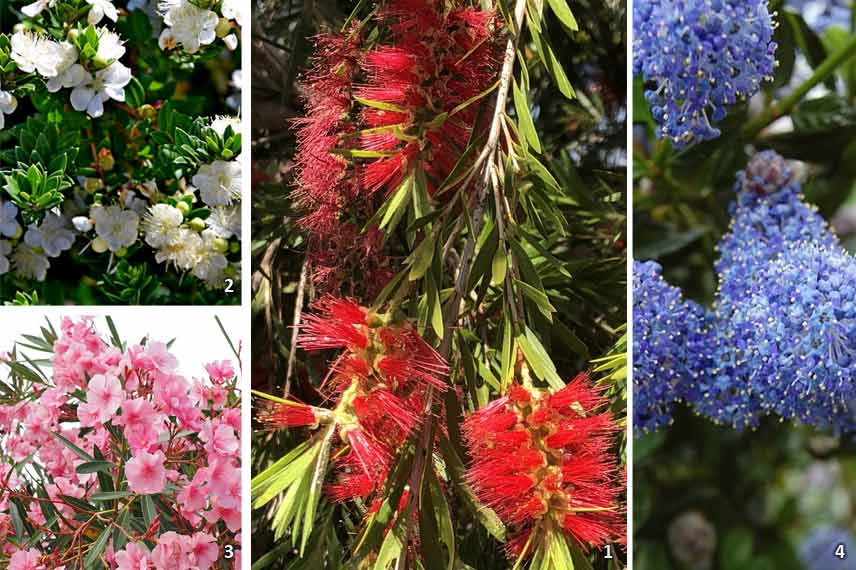
Callistemon rigidus: hardiest species with red flowers in the genus
Callistemon rigidus is a handsome bush with an upright and spreading habit which reaches 1.5 m in height at ripeness. It is provided with stiff branches and attractive evergreen foliage. Leaves are narrow, tapering, leathery, and have a dark green colour. From May to June, the bottlebrush produces abundant flowering in crimson-red bottlebrushes, dusted with golden-yellow pollen, which appear at the tips of young shoots. Callistemon rigidus is also valued for its hardiness. Indeed, it is the hardiest species with red flowers within the genus, capable of withstanding frosts of -10 to -12° C for short periods. This Callistemon is also very accommodating regarding the nature of the soil. It tolerates drought and lack of water well.
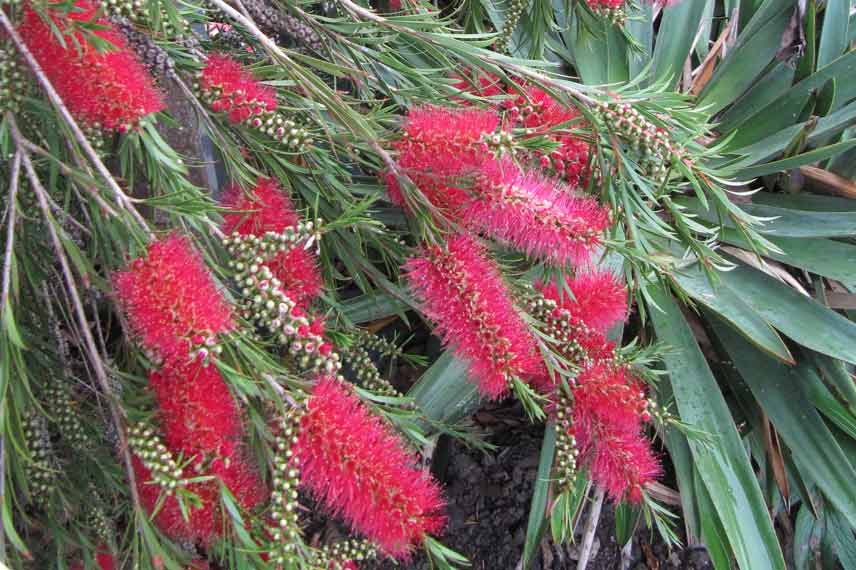
Callistemon rigidus ©Leonora (Ellie) Enking, Flickr
Some planting combinations
Callistemon rigidus₁ can, for example, be paired with rosemary₂, with Cistus x pulverulentus₃, with Convolvulus cneorum₄, and with Nepeta x faassenii₅, to create a bed of low-growing or groundcover plants. 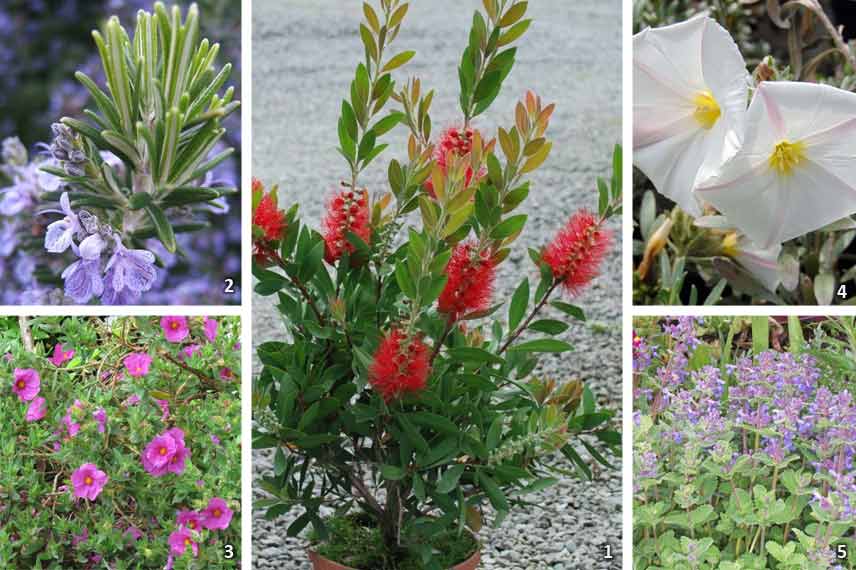
Callistemon salignus : a white-flowering Melaleuca
Callistemon salignus, or Melaleuca salicina, is a bush bottlebrush ramified, reaching up to 1.5 m in height at maturity. It is recognisable by its long trailing branches that bear evergreen, lanceolate grey-green leaves. Juvenile leaves, meanwhile, display an attractive pink-red. From May to July, the attractive whitish-green flowering of Callistemon salignus unfolds into numerous inflorescences bottlebrush-shaped. Very accommodating bush, this variety of Callistemon is hardy down to -7°C and tolerates occasionally dry, poor soil, or, conversely, moist and waterlogged soil. The bush adapts perfectly to cultivation in a large container. 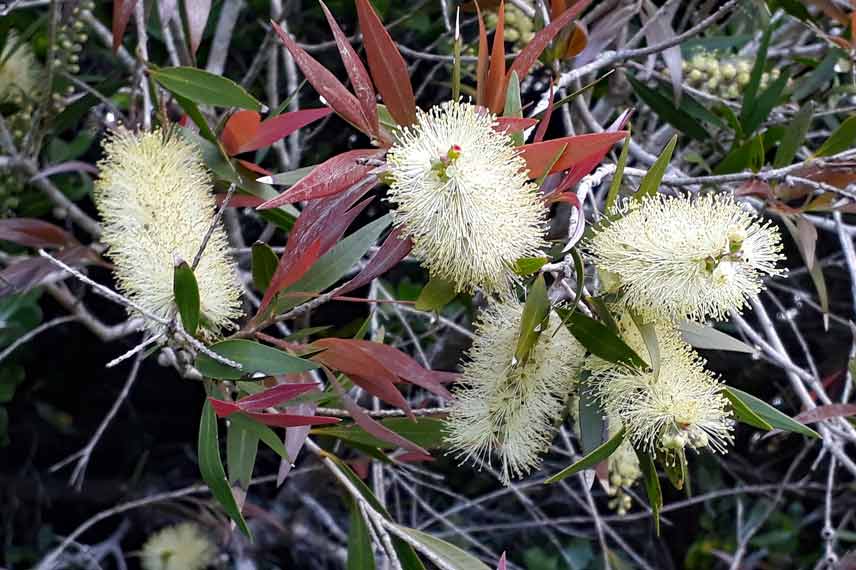
Some planting combinations
Callistemon salignus₁ can, for example, be paired with Eucomis pole-evansii₂, with Verbena bonariensis₃ and with Crocosmia ‘Mistral’₄ to create a mixed, exotic flowering border. 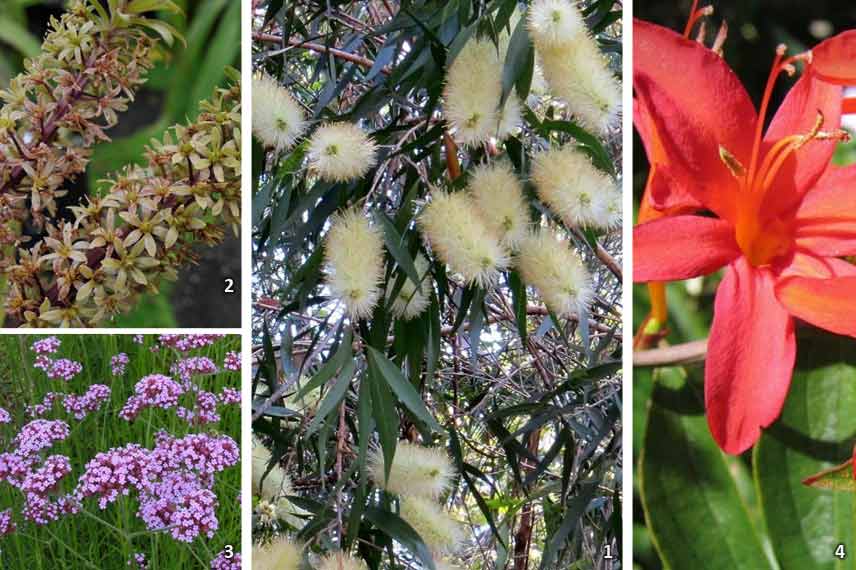
Callistemon masotti 'Mini Red' : a bush suited to small gardens and growing in pots
Callistemon masotti ‘Mini Red’ is a small variety that reaches 1.20 m in height at ripeness, with an 80 cm spread. This bottlebrush bush displays an upright, supple and dense habit. Its elegant evergreen foliage is green to slightly grey. The abundant flowering of this Callistemon is very early as it appears from March through May. It takes the form of magnificent scarlet bottlebrushes. This species is not very hardy and does not survive below -5 °C. It is nevertheless fairly accommodating, as it resists wind and sea spray well, and readily accepts container growing. Callistemon masotti ‘Mini Red’ however prefers soils that are not very calcareous. 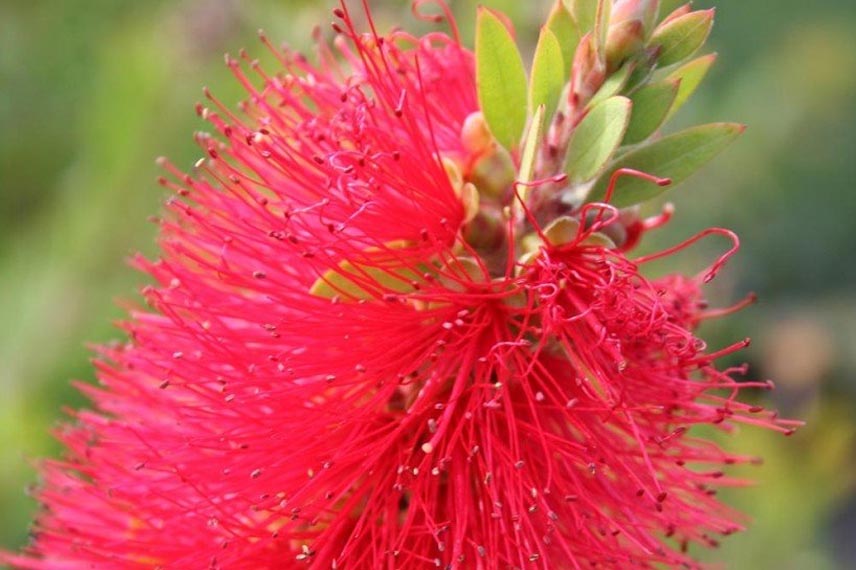
Some planting combinations
Callistemon masotti ‘Mini Red’₁ can, for example, be paired with Ceanothus ‘Italian Skies’₂ and ‘Concha’₃, with Cytisus praecox ‘Allgold’₄, and with Nerium oleander ‘Provence’₅ to form a handsome evergreen hedge. 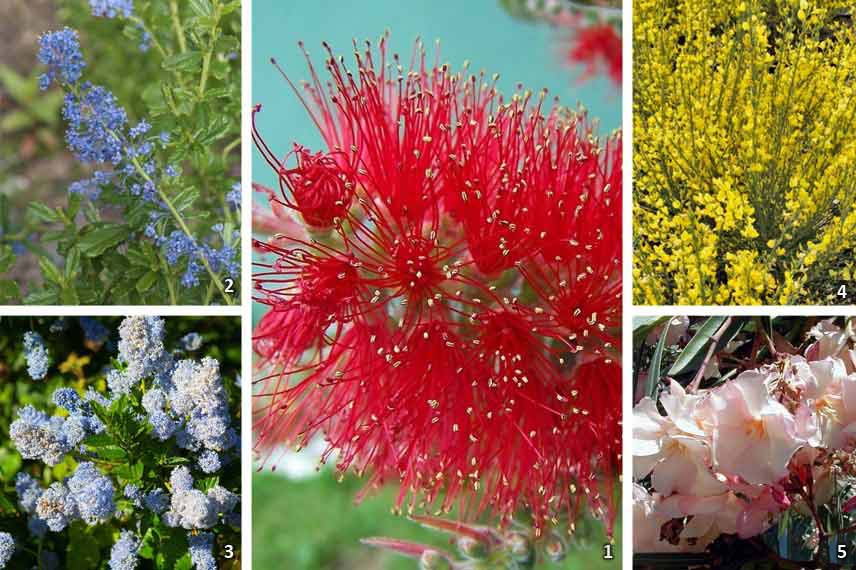
Callistemon viminalis 'Hot Pink': a bush with surprising fuchsia-pink flowering
Callistemon viminalis ‘Hot Pink’ is recognised by its astonishing and magnificent, striking fuchsia-pink flowers. This very pretty bush with a rounded, ramified habit of 1.7 m tall has elegant grey-green foliage finely divided, carried on flexible shoots. Flowering occurs between May and June, lasting an entire month, then more sporadically from August to September. It offers bright bottlebrush inflorescences, formed at tips of shoots, which become red at bud burst period. This cultivar is slightly more hardy than other varieties of Callistemons viminalis, as it can tolerate down to -5° C. This bottlebrush thrives in slightly calcareous to acidic, fresh to dry soils. 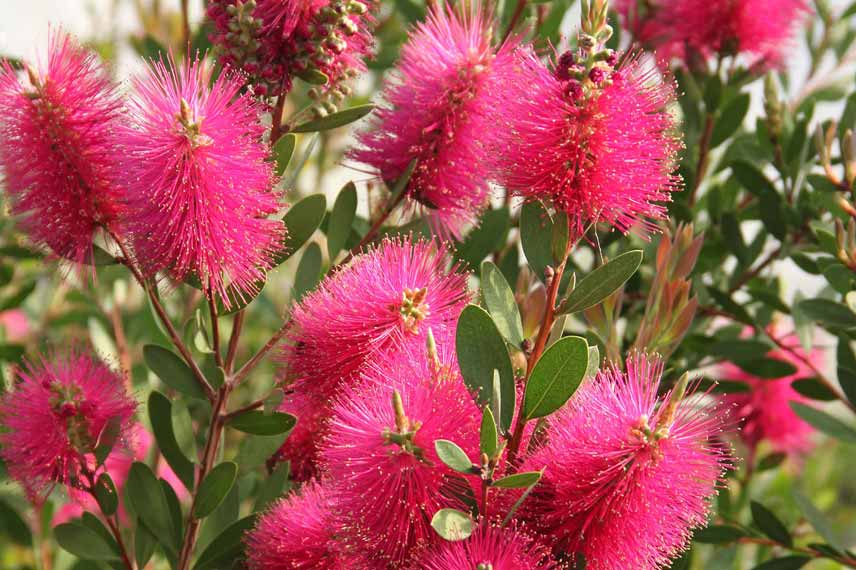
Some planting combination ideas
Callistemon viminalis ‘Hot Pink’₁ can, for example, be paired with Grevillea rosmarinifolia₂, Phormium ‘Margaret Jones’₃, Melaleuca gibbosa₄ and Leptospermum scoparium ‘Red Damask’₅. 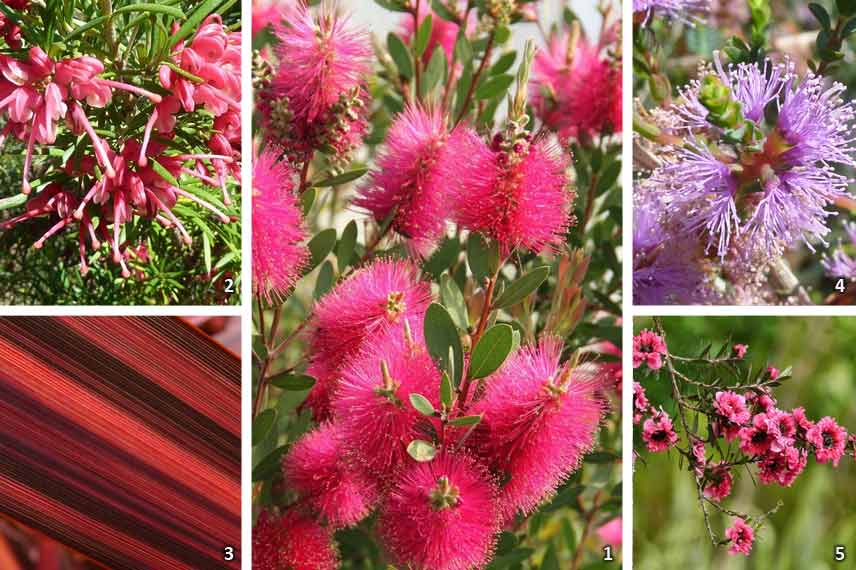
Callistemon citrinus 'Mauve Mist' : a variety with long mauve-pink flowering
Callistemon citrinus ‘Mauve Mist’ is a bush averaging 2.5 m in height with compact habit. With time, it becomes slightly weeping. This lovely bush is endowed with attractive evergreen, aromatic foliage that releases scent when crushed. It is characterised by young leaves tinged pale red. Between June and August, very attractive flowering of this Callistemon takes the form of bright pink-mauve bottlebrushes. This is a relatively hardy variety, capable of surviving temperatures around -7° to -8° C. Callistemon citrinus ‘Mauve Mist’ flowers for a long time during summer and tolerates drought well once fully established. However, it is more floriferous in fresh, neutral or acidic soil. 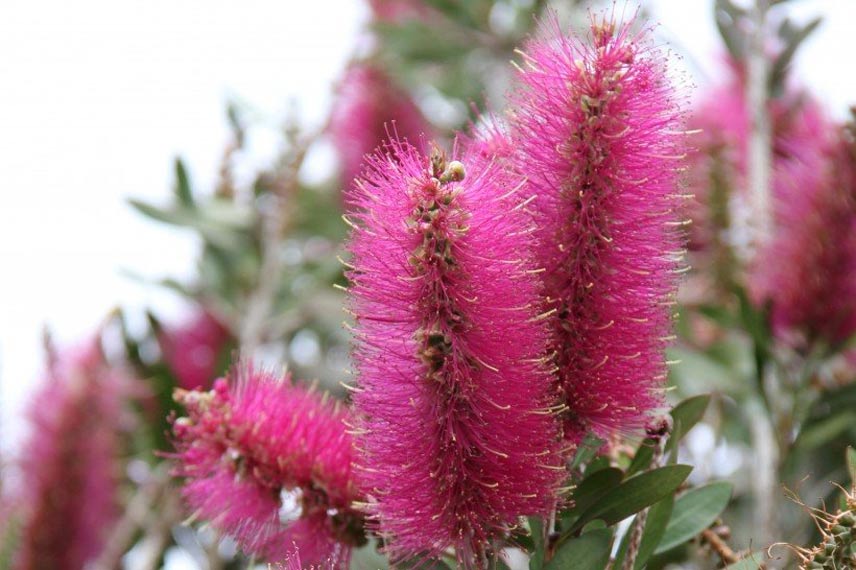
Some ideas for combinations
Callistemon citrinus ‘Mauve Mist’ can, for example, be paired with various Grevillea and Phormium, with Caesalpinia gilliesii, as well as with Leptospermum, to create a mixed border or informal hedgerow. 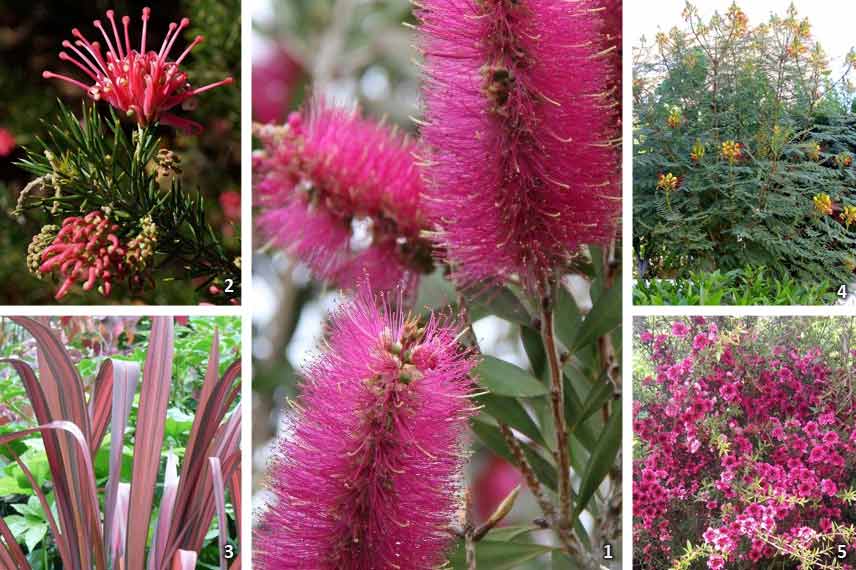
Useful links
Are you passionate about Callistemons? Here are two useful links to help you to grow them easily at home.
- To learn more, discover how to plant, prune and maintain Callistemon.
- Also find our selection of Callistemon for sale in our online shop.
- Discover our advice sheet: How to choose a Callistemon?
- Subscribe!
- Contents































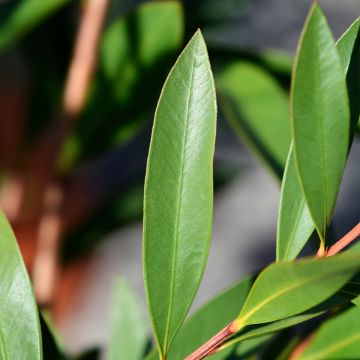
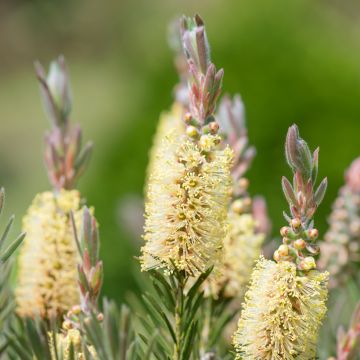
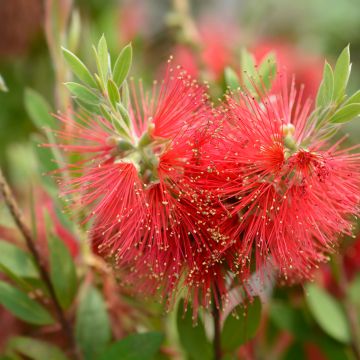
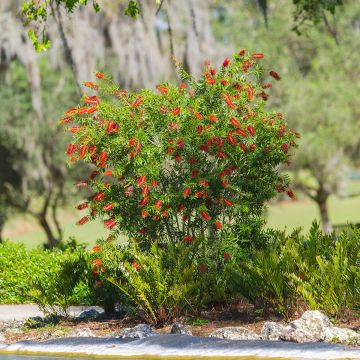
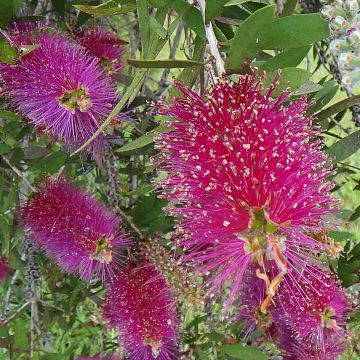
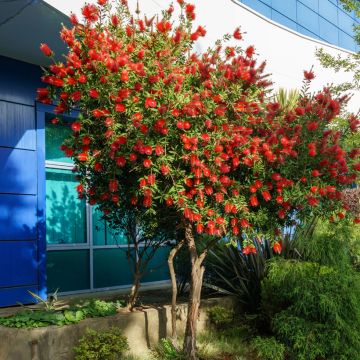
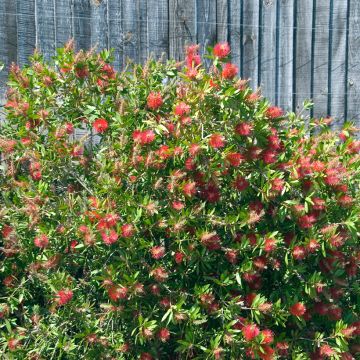
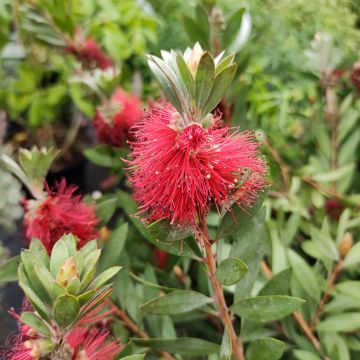
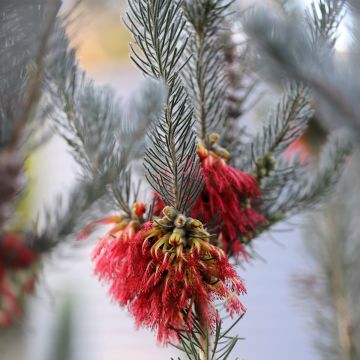
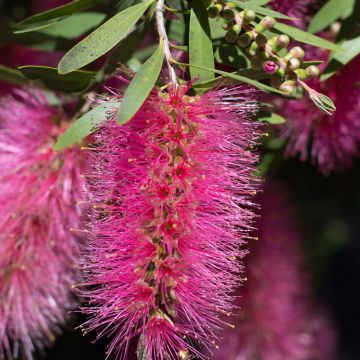
Comments